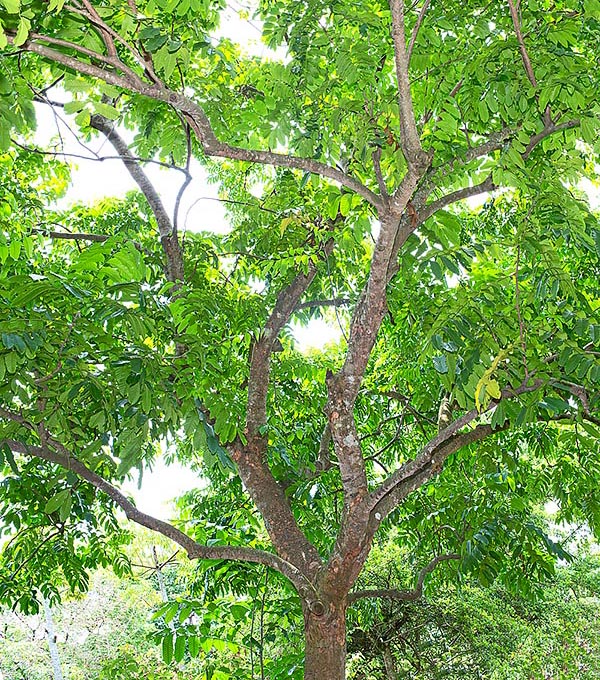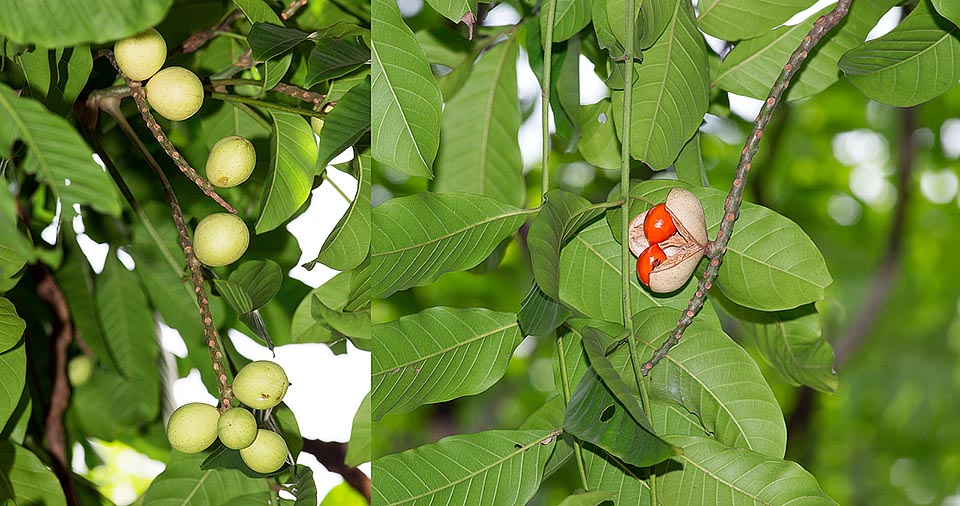Family : Meliaceae

Text © Pietro Puccio

English translation by Mario Beltramini

Aphanamixis polystachya is an evergreen tree of South-East Asia reaching 30 m of height © G. Mazza
The name of the genus is the combination of the Greek adjective “ἀφανής (aphanés) = invisible, inconspicuous and of the substantive“μίξις” (mixis) = mixture, with reference to the inconspicuous flowers; the specific name is the combination of the Greek adjective “πολύς” (polys) = much and “στάχυς” (stachys) = spike, with obvious reference.
Common names: amoora, pithraj tree, rohituka tree, white cedar (English); hakhori bakhor (Assamese); baddiraj, pitraj, tiktaraj (Bengali); shan lian (Chinese); harin-arà, rohida (Hindi); mullumuntaga, roheethaka (Kannada); cemmaram, sem (Malayalam); elahirilla, lakshmivana, lohita, rohitakah (Sanskrit); semmaram, vellakangu (Tamil); rohitaka, sevamanu (Telugu); lao hang, ma hang kan, ta suea (Thai).
The Aphanamixis polystachya (Wall.) R.Parker (1931) is a shrub or tree evergreen polygamous-dioecious (bearing on the same individual hermaphroditic as well as unisexual flowers), that can reach the 30 m of height, with cylindrical trunk with brown-reddish bark, longitudinally fissured, provided at the base, in the old specimens, of tabular roots (roots similar to buttresses). The leaves, spirally arranged, are pari or imparipinnate, 30-90 cm long, formed by 9-17 leaflets, on a 0,5-1 cm long petiolule, opposite, oblong-eliptic to ovate, 7-18 cm long and 4-8 cm broad, with long pointed to obtuse apex and entire margins, of intense green colour. Axillar drooping inflorescences, 30-60 cm long, bearing subsessile globose flowers, of about 0,6 cm of diameter, with 3-5 sepals and 3-5 orbicular petals, concave, white, globose staminal tube, 0,4 cm long, 6 anthers and pubescent trilocular ovary. The fruits globose to pyriform capsules, of 2,5-3 cm of diameter, yellowish to purple when ripe, dehiscent in 3 valves and containing 1-3 oblong seeds, flattened, of brown grey colour, about 1,4 cm long and 1 cm broad, immersed in red aril.
It usually reproduces by seed, that must be planted in the shortest possible time having a short lasting germinability, 2-3 months, with 2-4 weeks of germination time.
At times cultivated as ornamental in the tropical and humid subtropical climate zones, owes its fame in the origin places to the medicinal properties ascribed. It requires full sun or slight shade and adapts to an ample variety of soils, preferably draining, maintained almost constantly humid.
The fruits, toxic, contain about the 40% of oil utilized in the fabrication of soaps, as lubricant and for illumination, moreover, it presents promising characteristics for a possible use as biofuel. The wood, of excellent quality is utilized in the civil and naval constructions, for furniture and common use objects.
Various parts of the plant are utilized since remore times in the traditional medicine, in particular Indian, as antibacterial, anthelmintic, anti-malarial, anti-tumor, in the liver and spleen diseases, in anemia and abdominal discomforts; the oil extracted from the fruits is employed as rheumatisms liniment.

The fruits, toxic, contain 2-3 seeds protected by a red aril. The oil extracted is used to produce soaps and various parts of the plant display promising medicinal virtues © Giuseppe Mazza
Laboratory studies have evidenced in the plant the presence of various bioactive compounds of possible interest in the official pharmacopoeia. The extracts from the leaves and from the fruits present interesting insecticidal properties.
Synonyms: Andersonia rohituka Roxb. (1824); Aphanamixis grandifolia Blume (1825); Sphaerosacme polystachya Wall. (1829); Sphaerosacme spicata Wall (1831); Aphanamixis perrottetiana A.Juss. (1832); Aphanamixis timorensis A.Juss. (1832); Amoora rohituka (Roxb.) Wight & Arn. (1833); Trichilia tripetala Blanco (1837); Amoora polystachya (Wall.) Steud. (1840); Aphanamixis blumei Span. (1841); Amoora grandifolia Walp. (1842); Amoora amboinensis Miq. (1868); Dysoxylum spiciflorum Zipp. ex Miq. (1868); Dysoxylum cuneatum Hiern (1875); Amoora cumingiana C.DC. (1878); Alliaria cuneata (Hiern) Kuntze (1891); Amoora myrmecophila Warb. (1894); Aphanamixis amboinensis (Miq.) Harms (1896); Aphanamixis cochinchinensis Pierre (1896); Aphanamixis cumingiana (C.DC.) Harms (1896); Aphanamixis myrmecophila (Warb.) Harms (1896); Aphanamixis rohituka (Roxb.) Pierre (1897); Aphanamixis lauterbachii Harms (1900); Aphanamixis macrocalyx Harms (1900); Amoora elmeri Merr. (1905); Aglaia aphanamixis Pellegr. (1911); Aglaia cochinchinensis (Pierre) Pellegr. (1911); Amoora polillensis C.B.Rob. (1911); Aphanamixis coriacea Merr. (1916); Aphanamixis elmeri (Merr.) Merr. (1916); Aphanamixis tripetala (Blanco) Merr. (1918); Aphanamixis polillensis (C.B.Rob.) Merr. (1923); Aglaia polystachya Wall. (1924); Canarium vrieseo-teysmannii H.J.Lam (1932); Aphanamixis pinatubensis Elmer (1934); Aphanamixis agusanensis Elmer (1937); Aphanamixis apoensis Elmer (1937); Aphanamixis davaoensis Elmer (1937); Aphanamixis obliquifolia Elmer (1937); Aphanamixis velutina Elmer (1937); Chuniodendron spicatum Hu (1938); Chuniodendron yunnanense Hu (1938); Epicharis cuneata (Hiern) Harms (1940); Aglaia janowskyi Harms (1942); Aphanamixis schlechteri Harms (1942); Aphanamixis sinensis F.C.How & T.C.Chen (1955); Amoora janowskyi (Harms) Kosterm. (1966); Amoora beddomei Kosterm. (1982); Ricinocarpodendron polystachyum (Wall.) Mabb. (1982); Aglaia beddomei (Kosterm.) S.S.Jain & R.C.Gaur (1986).
→ To appreciate the biodiversity within the MELIACEAE family please click here.
